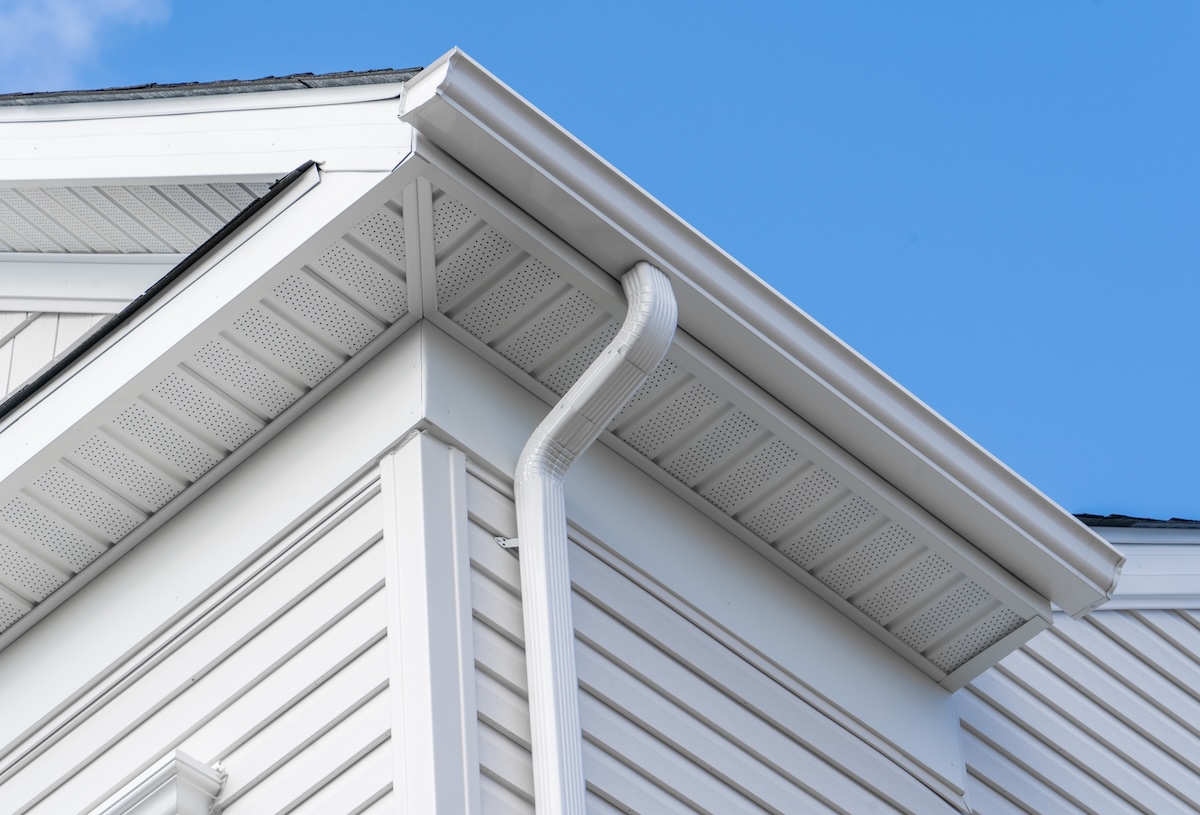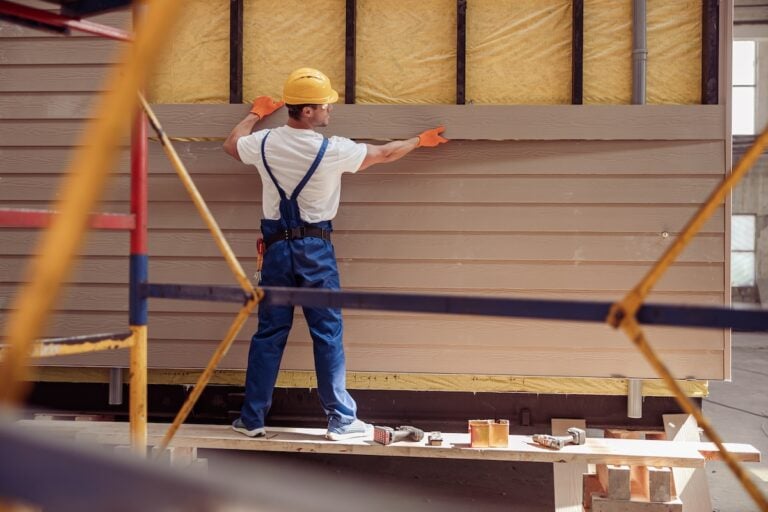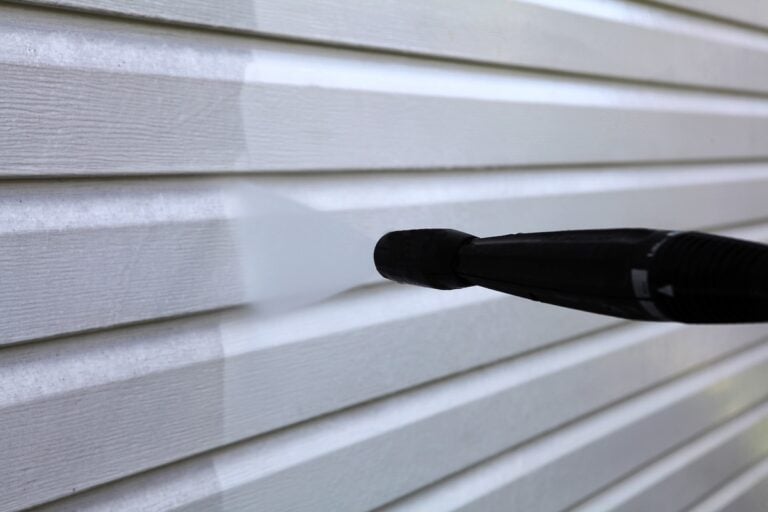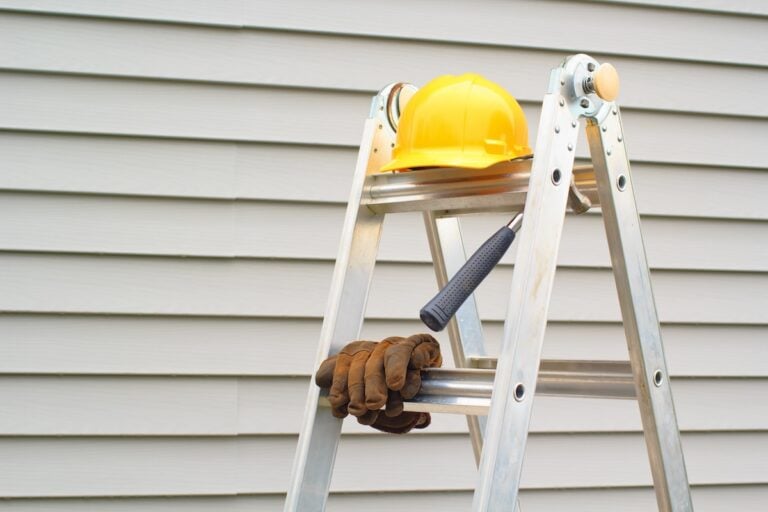Keeping your home’s exterior looking sharp doesn’t have to be complicated, especially if you stay on top of vinyl siding maintenance. With just a few tools and some seasonal upkeep, you can extend the life of your siding, prevent costly repairs, and boost your curb appeal.
In this guide, we’ll cover:
- Routine care that protects your siding: Easy cleaning and inspection tips.
- DIY fixes for minor issues: From loose panels to mildew control.
- When to repair or replace: So you’re not caught off guard.
Let’s dive into how to keep your vinyl siding looking great all year long.
🛠️ Why Vinyl Siding Maintenance Matters
Vinyl is one of the most low-maintenance siding materials available, but that doesn’t mean it’s maintenance-free. Like any part of your home’s exterior, it’s constantly exposed to the elements.

Benefits of Proper Maintenance
Routine upkeep helps you avoid bigger problems down the road.
- Prevent moisture damage: Cleaning and sealing gaps helps stop water intrusion.
- Keep your home looking fresh: Remove grime, mold, and mildew before it stains.
- Extend siding lifespan: Well-maintained siding can last 30+ years.
- Catch small issues early: You’ll spot cracks or loose panels before they worsen.
By spending a little time now, you’ll avoid expensive repairs later.
✅ Step-By-Step Vinyl Siding Maintenance Routine
A solid vinyl siding maintenance routine involves just a few seasonal tasks. Follow these steps to protect your home’s exterior and keep it looking its best.
Step 1: Perform a Visual Inspection
Start by walking around your home and checking for common issues.
- Look for cracks or holes: These allow moisture or pests to enter.
- Check for loose panels: Wind or impact can dislodge sections of siding.
- Inspect around doors, windows, and corners: These are common areas for gaps or caulking failure.
- Look for signs of warping: Buckled panels may indicate heat damage or improper nailing.
Take note of any areas that need cleaning, repair, or replacement.

Step 2: Clean the Siding (Once or Twice Per Year)
Even if your siding isn’t visibly dirty, regular cleaning helps remove hidden buildup.
- Rinse with a garden hose: Start from the bottom and work your way up, then rinse from top to bottom.
- Use a soft brush or long-handled scrubber: Combine with a mild solution of dish soap and warm water.
- Try white vinegar for mildew: A 30:70 vinegar-to-water solution works well for mildew-prone areas.
- Avoid harsh chemicals and bleach: These can damage the siding or harm nearby landscaping.
For larger jobs, a pressure washer with a wide-angle (25–40°) nozzle on low pressure is acceptable, but always spray level or downward to prevent water intrusion.
Step 3: Re-Caulk Seams and Gaps
Vinyl siding expands and contracts with temperature changes, which can create small gaps over time.
- Use paintable exterior-grade caulk: Choose a product labeled for siding or windows/doors.
- Target trim edges, joints, and utility penetrations: These areas are most vulnerable to leaks.
- Check around windows and doors: Replace old or cracked caulk to prevent drafts and moisture.
This small task goes a long way in keeping water and pests out.
Step 4: Tighten Loose Panels
If a piece of siding is rattling in the wind or seems misaligned, it may just need to be re-secured.
- Use a zip tool: This inexpensive tool unlocks siding seams.
- Slide the panel back into place: Make sure it’s properly hooked at the top and bottom.
- Avoid nailing panels tight: Vinyl needs room to expand and contract.
If a section is badly warped or damaged, consider replacing that panel entirely.
Step 5: Trim Overgrown Landscaping
Vegetation close to your home can trap moisture and wear down your siding’s surface.
- Keep bushes and shrubs 1–2 feet away: This prevents abrasion and encourages air flow.
- Trim tree branches: Avoid direct contact with siding, especially in windy areas.
- Remove ivy or vines: These can cling to and damage the surface over time.
Landscaping and siding should complement each other, not compete.
❗️ Common Vinyl Siding Issues (And How To Fix Them)
Even with regular maintenance, small problems can pop up. Here’s how to handle the most common ones.
Mold and Mildew Buildup
If you notice dark or green streaks, you’re likely dealing with mildew or algae.
- Use a vinegar solution: Spray, let sit for 10 minutes, then scrub gently.
- Avoid bleach: It may discolor the siding or damage nearby plants.
- Keep areas dry: Trim trees and clean gutters to prevent excessive moisture.
Regular cleaning and airflow reduce the risk of mold buildup.
Cracks and Holes
Impact damage from hail, rocks, or sports equipment can cause cracks or punctures.
- Seal small holes with exterior caulk: This is a temporary fix for weather protection.
- Replace the panel: For best results, replace damaged siding with a matching piece using a zip tool.
Cracks can let in moisture and insects, so address them promptly.

Faded or Discolored Siding
Vinyl can fade over time due to UV exposure.
- Repaint with vinyl-safe paint: Choose a lighter color to avoid warping.
- Don’t paint dark colors over light siding: This can absorb too much heat and distort the panels.
Painting is a cost-effective way to refresh your siding’s look without full replacement.
🗓️ Vinyl Siding Maintenance Schedule
Here’s a simple maintenance calendar to follow throughout the year:
| Season | Tasks |
| Spring | Full inspection, clean siding, re-caulk as needed |
| Summer | Trim vegetation, check for heat warping or grill damage |
| Fall | Clean again if needed, inspect after storms, touch up paint |
| Winter | Watch for ice buildup, avoid leaning shovels or salt against siding |
Following this routine helps you stay ahead of issues and keep your home in great shape year-round.
📞 When To Call A Professional
Sometimes, it’s best to bring in the pros, especially if:
- You find widespread warping or discoloration
- Your siding is over 20 years old and showing signs of failure
- There’s hidden moisture damage or mold behind the panels
- You need help color-matching or sourcing discontinued siding
At Boss Exteriors, our team offers honest inspections and clear recommendations. We’ll never upsell what you don’t need—and we’re happy to assist with anything from simple panel replacements to full siding upgrades.

💪 Take Pride in Your Home’s Exterior
Vinyl siding maintenance doesn’t have to be a hassle. With a few routine habits and some basic tools, you can keep your home protected, attractive, and in top condition for years to come.
Whether you’re dealing with mildew, minor damage, or just want peace of mind, Boss Exteriors is here to help. Our team of exterior experts can guide you through siding repairs, replacements, and maintenance with professional care and friendly service.
Need a hand with your siding maintenance? Contact Boss Exteriors today to schedule an evaluation or receive a repair estimate you can trust.





